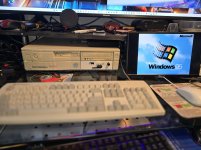If you haven't already, check out the
PicoGUS. I picked up one and it is amazing if you don't mind emulators, which many of the cards use to a degree. For my Gateway 4DX2-66 it initially came with the Ensoniq Soundscape but the card died thanks to leaky caps destroying the board and some of the components. I replaced it with a Sound Blaster 16 as that was what I put in my original Gateway 486. But then I swapped it out with a Sound Blaster Pro 2 as I thought it would be a better choice for the games I play on it.
I am right with you, sound to me (Specifically Sound Blaster 16), as well as 256 color VGA graphics is what got me into DOS gaming coming from an Amiga which was all about sound and graphics.

